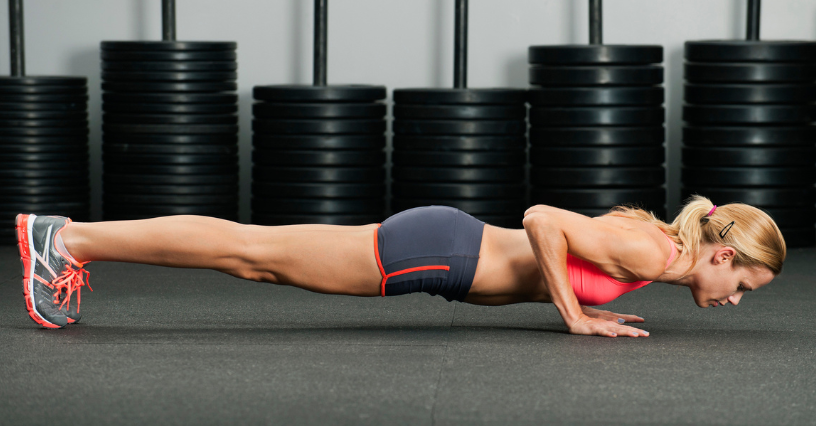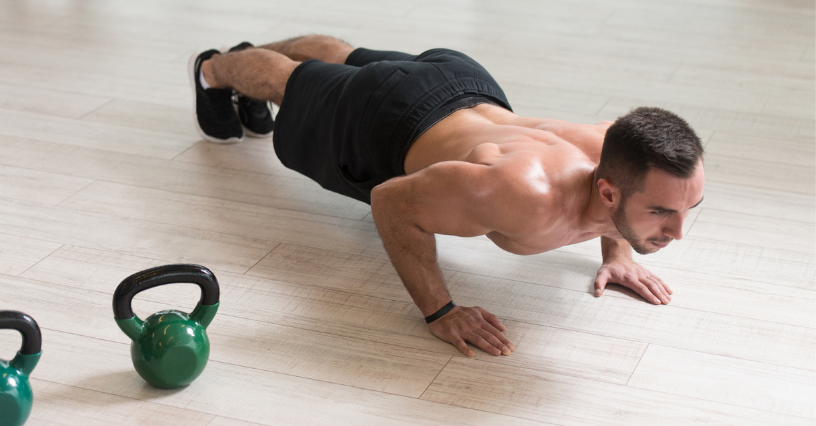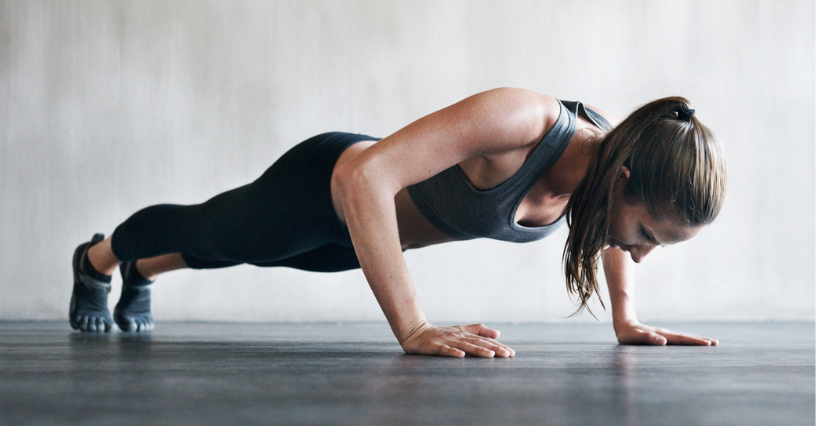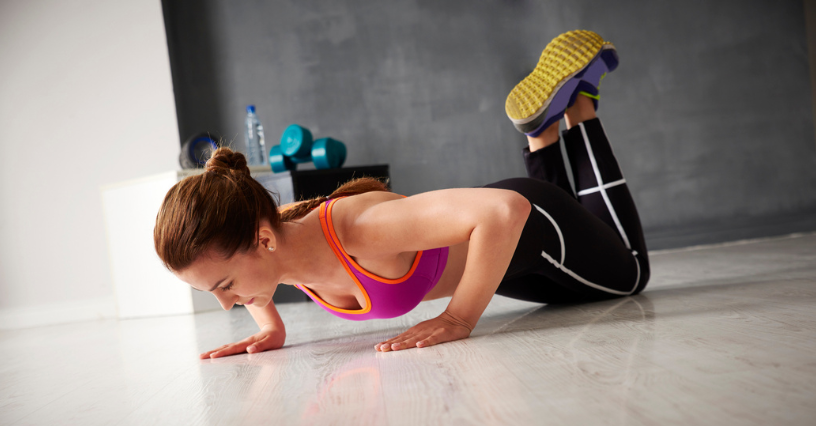Push-ups are one of the best bodyweight exercises to strengthen your upper body muscles and improve your overall fitness.
Despite the widespread familiarity with this exercise, not everyone knows how to perform push-ups correctly, which muscles work exactly when they are done and why it is worth including them in your training routine. You can find the answers in our guide.
What do push-ups do?
Push-ups are one of the most complete upper body exercises you can do without using any exercise equipment. Due to the involvement of several muscle groups, it is perfect for strengthening not only the chest muscles, but also the triceps and shoulders, as well as for strengthening the abdominal and lumbar muscles.
Moreover, due to the simplicity of the movement and the different variations, this exercise is suitable for practically everyone, regardless of the goal they want to achieve.
For example, bodybuilders and those working on building a well-sculpted physique can use push-ups as a superset during chest training. On the other hand, people who lift heavy weights regularly may get better results by using push-ups with additional resistance (eg power band).
Adding push-ups to an aerobic workout can boost your metabolism, which translates into more calories burned, and when combined with a balanced diet, can help improve your body composition and proportions.
Because push-ups involve lifting your own weight, it’s an effective way to monitor your level of strength growth. For example, the effects of doing push-ups after 2 months are a full straight leg push-up or more advanced variations of it.
Progress can be seen not only in performing the exercise itself, but also in everyday life (for example, it will be easier for you to lift heavier weights than before).
In addition, some studies have shown that being able to do more than 40 push-ups can reduce the risk of cardiovascular disease, including strokes and heart attacks, compared to people who can do fewer than 10 repetitions.
It is worth remembering that depending on your goal: expanding the chest muscles, improving endurance or improving general strength, a training plan is necessary that takes into account the appropriate volume of exercises (sets and repetitions), the type of push-ups and the intensity of the effort .

What muscles work during push-ups?
Primarily, push-ups engage the chest muscles, including the pectoralis major and pectoralis minor. The first consists of two heads (clavicular and sternoclavicular), is thick and fan-shaped.
Its function is to control the movement of lowering the trunk towards the ground and pushing the body back to the original position.
On the other hand, the pectoralis minor muscle has a triangular shape, and its main role when performing push-ups is to keep the scapula in the proper position.
The push-up is a compound exercise, meaning it engages multiple muscle groups in addition to the structures above. During push-ups, muscles such as:
- triceps – is located on the back of the arm. It helps to keep the trunk stable during the descent of the trunk, while on the return it is the main element that drives the movement ;
- the anterior deltoid muscle of the shoulder – during the descent phase, they are responsible for stabilizing the arms, and during the ascent they help to pull the arms towards the chest ;
- Abdominal muscles and deep muscles ( including dorsal extensors and multifidus muscle ) – are involved in keeping the trunk and spine straight to maintain good posture .

How to do push-ups? Correct technique
To perform classic push-ups correctly:
- get into a high plank position – hands shoulder-width apart, feet hip-width apart or together. Pull your shoulder blades toward your spine and lower them. Engage your core muscles, glutes and legs to align your body. Bend your pelvis up to your navel, with your navel pointing toward your spine. Tightens the gluteal muscles. Keep your back straight ;
- inhale and begin to bend your elbows to the sides of your body. Keep them at an angle of about 45 degrees ;
- gradually lower your body until your chest touches the floor or is 2-3 cm above it ;
- exhale and begin to raise your hands to the starting position. Focus on maintaining adequate tension in your triceps, chest muscles, and deep muscles .

The most common mistakes during push-ups
Although push-ups are a relatively simple movement, both beginners and strength training enthusiasts can make some fairly common mistakes that negatively affect the effectiveness of this exercise. Here are the most common mistakes when doing push-ups:
- dropped hips and lower back – a deep lordosis in the lower spine causes a loss of energy that should be delivered to the muscles most involved in this exercise. To correct this, engage your core muscles (the deep muscles that stabilize your posture, i.e. the transverse abdominal muscles, among others) and leg muscles. Bend your pelvis toward your navel and “suck” your navel into your spine. The body must form a single line from the beginning to the end of the movement ;
- extending the arms to the sides so that they form a T-shape with the torso – a simple way to stress the shoulder and elbow joints. The correction of this mistake is done by pushing the elbows towards the trunk and turning the palms slightly outwards ;
- head down – can lead to tension in the cervical spine. Make sure there is an extension of the spine throughout the exercise ;
- descending and/or ascending too quickly – moving too quickly can make you unable to keep your muscles properly tense, which will expose you to incorrect technique and ineffective exercises. Try to do a push-up for 3-5 seconds or slower, fully focusing on proper muscle tension ;
- a too short movement of the trunk down – if you do not lower the trunk down enough, the exercise will not have the desired effect ;
- back bend – try to pull the shoulder blades back towards the spine and down .

Push-ups for beginners. The most important tips
If you’re new to push-ups, focus on developing proper technique. You start with a low number of reps (eg 10 push-ups, 3-6 reps in 3-4 sets, or any number you can do with proper technique) and a slow pace.
As you become more advanced, increase the volume and intensity of the exercises. If you immediately start with a big “C” and perform a large number of push-ups every day at a fast pace and without focusing too much on technique, you will not only develop an aversion to this exercise in a short time, but from due to the lack of a good movement pattern you can injure yourself.
If you have trouble holding the plank position to begin with, choose the so-called ladies’ push-ups, which are performed on your knees. You can also use a step height to put your hands on to start.
How often to do push-ups?
You can even do push-ups every day, but it pays to listen to your body and remember that your muscles need time to recover, otherwise you’ll end up overworking them.
In addition, over time, your muscles get used to the movement, which leads to, among other things, a lack of progress.
So it’s a good idea to give them a boost by choosing a different type of push-up that will test your muscles, or using push-ups as part of a warm-up, interval or functional workout. You can also use additional accessories, such as handrails or handles for push-ups .



